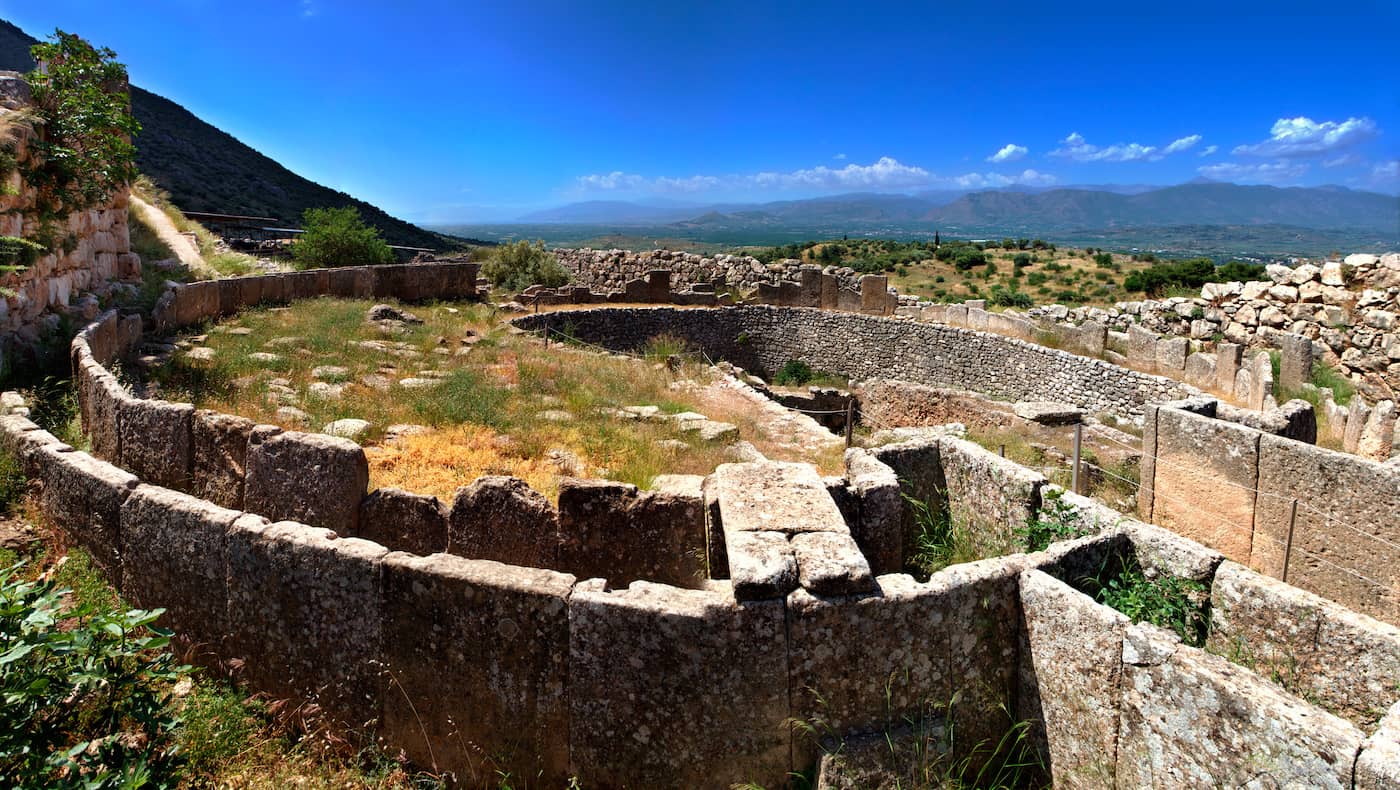Grave Circle B
Burial Circle B was part of the prehistoric cemetery of Mycenae (late 17th, early 16th century BC)-similarly to Grave Circle A- and nowadays is located outside its walls of the Acropolis. It was excavated by I. Papadimitriou and G. Mylonas during the period 1952-1954. It is surrounded by a series of enormous dry stones (28 m. in diameter) and includes 14 large shaft tombs similar to those of Grave Circle A, intended for members of the royal family, as well as 12 smaller and shallow tombs, intended for the attendants of the palaces. The 26 tombs were found scattered in the area without consistent orientation. On top of several tombs rose vertical stone columns, five of which were found in their original position. The columns, decorated with embossed representations, belong to male burials, while the unadorned ones belong to women.
The bones of about 35 men, women and children were found in the tombs of Grave Circle B, most of whom were untouched. The men were between 23 and 55 years old, while women were between 30 and 37 years old. The healed wounds on the heads and the spine of most men suggest that these men were involved in battles, especially taking into account the signs of particular muscular strength.
It is known that funerary dinners were held over the tomb. This ceremony is confirmed by animal bones and pottery fragments found in the soil. Pebbles were laid on the floor of the tomb, on top of which the corpse was placed in a timid or extended position. No cremation evidence was found. It was recently proved that the Mycenaeans used to wrap the dead and their offerings before burying them with papyrus leaves. This is, at least, what is speculated on the basis of the plant remains, which were identified by the professors of Archeology G. Mylonas and S. Marinato in 1952-1954, during the excavation of the Garve Circle B of Mycenae. The information is confirmed by Maria Vlassopoulou-Karydi, archaeologist of the National Archaeological Museum, who, fifty years later, discovered these plant remains in the warehouse of the Prehistoric Collection of the Museum along with soil remains from the excavation. The presence of papyrus and its depiction on the ceramics and the well-known daggers of the tombs of Mycenae, testify to the relations between the Cretan-Mycenaean civilization with Egypt, the homeland of the cultivation and processing of the papyrus.
The offerings of the Garve Circle B are similar to those of Grave Circle A, although the wealth in this case is generally less. Nonetheless, there are some significant pieces, such as the amber funerary mask -gold and silver alloy- and the amethyst seal stone with a representation of a male figure of tomb C, as well as the cymbe in the form of a duck made of rock crystal in tomb O. The grave offerings present local characteristics, which follow the Middle Helladic tradition but, at the same time, present many imported elements from Minoan Crete and the Cyclades. The co-existence of such elements characterizes the era of the shaft tombs of Mycenae and contributed to the genesis of the Mycenaean civilization.
Tomb C, one of the largest tombs of Grave Circle B, contained burials of one female and 3 men. An embossed stone column with a representation of an armed man attacking a lion, was erected on the tomb. The skull of one of the skeletons, which belonged to a 28-year-old man, had been drilled in an effort to treat a possible hematoma. This operation, one of the oldest in Europe, requires medical knowledge, great courage and skill. Inside the tomb in-between the offerings, an amber funerary mask -gold and silver alloy-, an amethyst seal with engraved male head admiring art, two gold cups and bronze weapons were found.
Three dead were buried in tomb D and their grave goods are dominated by weapons. An important find is the long bronze sword with gold plating on the handle and two facing lion heads at the end of its base. Long and short swords, bronze knives, spears, daggers and stone arrowheads were offered to the warriors of the shaft tombs of Mycenae.
Tomb O belonged to a woman with grave offerings such as gold jewelry, diadems with imprinted decoration and necklaces. The name “tomb of crystals” is conventional and is related, on the one hand to the a remarkable cymbe made of rock crystal in the shape of a duck and, on the other hand, to some bronze pins with ornate heads made of rock crystal. The necklaces made of a variety of gemstones, as well as the necklace made of amber (precious material, imported from NW Europe) are, also, interesting.
The architectural form of the tomb of the last tomb P (15th century BC) seems to follow Eastern models. The tomb includes a built chamber that is accessible by a covered road. Only a small number of grave offerings escaped looting. Its form, however, constitutes another element that suggest the existence of relations between the Mycenaeans and the East.

